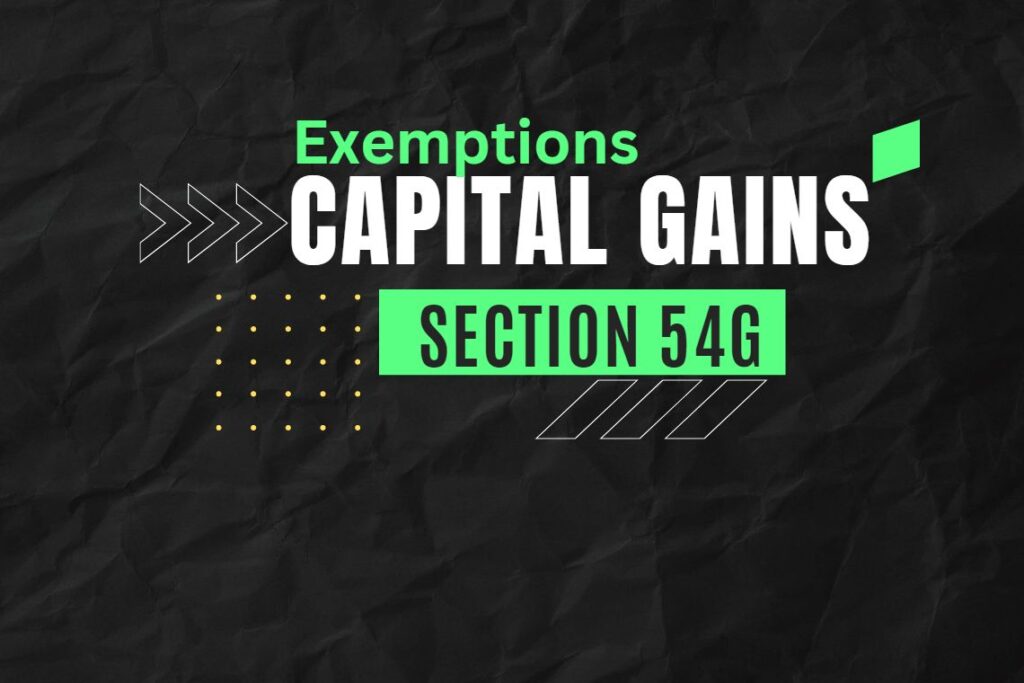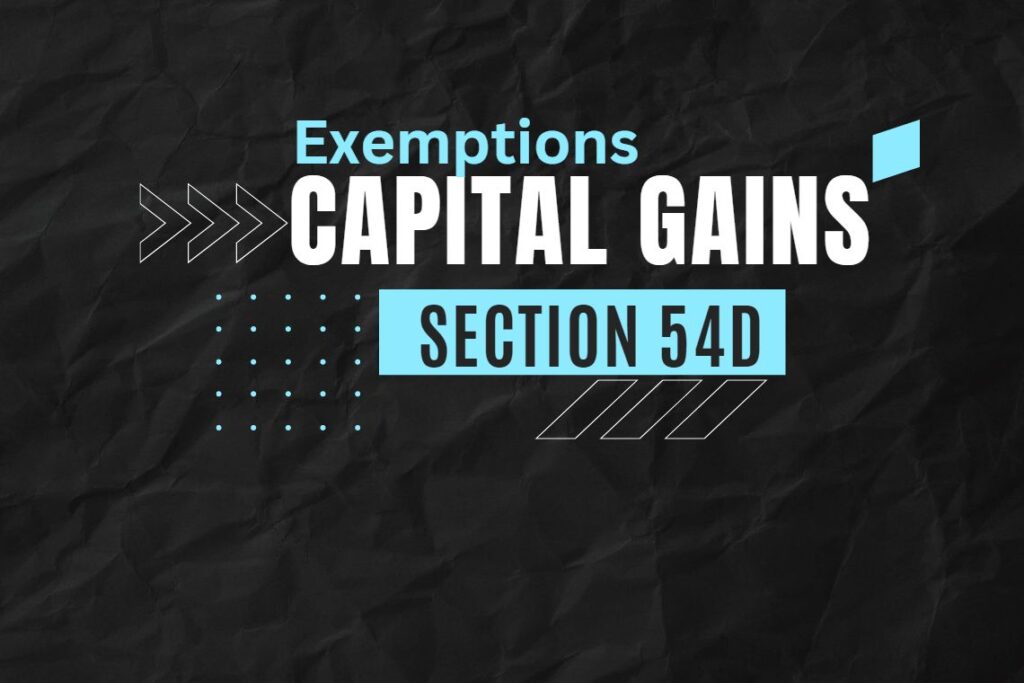In India, the Income Tax Act provides various exemptions to taxpayers to encourage investments and promote economic growth. One such exemption is provided under Section 54F of the Income Tax Act, which deals with the exemption of capital gains on the transfer of assets other than a residential house.
Section 54F of the Income Tax Act allows an individual or a Hindu Undivided Family (HUF) to claim exemption from long-term capital gains tax if the proceeds from the transfer of a capital asset other than a residential house are invested in the purchase of a new residential house property.
As per Section 54F, Any long-term capital gain, arising to an individual or HUF, from the transfer of any capital asset, other than residential house property, shall be exempt in full, if the entire net sales consideration is invested in purchase of one residential house in India within one year before or 2 years after the date of transfer of such an asset or in the construction of one residential house in India within 3 years after the date of such transfer. Where part of the net sales consideration is invested, it will be exempt proportionately.
The proportionate exemption shall be that amount of capital gains which bears the same proportion which the amount invested in the new house bears to the net consideration price of the asset transferred i.e.,
[Long-Term Capital Gain x Amount invested / Net Sale Consideration]
The above exemption shall be available only when the assessee does not own more than one residential house property on the date of transfer of such asset exclusive of the one which he has bought for claiming exemption u/s 54F.
in other words, where an individual or HUF transfers any long-term capital asset, not being a residential house, and invests the net sale proceeds to acquire a residential house, the exemption u/s 54F is available provided following conditions are satisfied:
(i) the asset is transferred by an individual or HUF;
(ii) the asset transferred is a long-term capital asset;
(iii) the asset transferred is any capital asset other than a residential house;
(iv) the assessee has purchased one residential house in India within one year before or 2 years after the date on which the transfer took place or constructed one residential house in India within a period of 3 years after the date on which transfer took place;
(v) the assessee does not own more than one residential house on the date of transfer of the original asset, exclusive of the one purchased for claiming exemption under this section, i.e., section 54F;
(vi) the assessee should not purchase, within a period of two years after the date of transfer of original asset or construct within a period of 3 years after the date of transfer of original asset, any other residential house other than the new asset.
Quantum of deduction
- If the net sale consideration of the original asset is equal to or less than the cost of the new house, the entire capital gain shall be exempt.
- If the net sale consideration of the original asset is greater than the cost of the new house then the exemption shall be allowed in the same proportion in which the cost of the new house bears to the net sale considerations, i.e., it shall be allowed proportionately as under:
[Long-Term Capital Gain x Amount Invested in the New House / Net Sale Consideration]
| IMPORTANT NOTES
1. Exemption is available under section 54F in respect of capital gains arising on transfer of any asset other than a residential house. Capital gain on sale of plots are also eligible for exemption. 2. As per the circular of CBDT, the cost of the land is an integral part of the cost of the residential house, whether purchased or constructed. 3. The construction of the new house may start before the date of transfer, but it should be completed after the date of transfer of the original asset. 4. Net consideration means the full value of the consideration as a result of the transfer of the capital asset minus any expenditure incurred wholly or exclusively in connection with such transfer. |
Provisions of Section 54F in detail
Let us understand the provisions of Section 54F in detail:
Conditions for claiming exemption under Section 54F
To claim exemption under Section 54F, the following conditions need to be satisfied:
- The taxpayer should be an individual or a Hindu Undivided Family (HUF).
- The capital asset transferred should not be a residential house.
- The taxpayer should purchase a new residential house property within the prescribed time limit.
- The taxpayer should not own more than one residential house, other than the new house, on the date of transfer of the original asset.
- The taxpayer should not purchase any other residential house within a period of two years from the date of transfer of the original asset.
Amount of exemption under Section 54F
If the above conditions are satisfied, the amount of exemption under Section 54F would be calculated as follows:
The amount of exemption would be the lower of the following:
- The amount invested in the purchase of the new residential house property
- The amount of long-term capital gains
It is important to note that if the amount of long-term capital gains is less than or equal to the amount invested in the new residential house property, the entire amount of long-term capital gains would be exempt from tax.
Time limit for investing in a new residential house property
To claim exemption under Section 54F, the taxpayer should purchase a new residential house property within the prescribed time limit. The time limit is as follows:
- The taxpayer should purchase the new residential house property within one year before the date of transfer of the original asset; or
- The taxpayer should purchase the new residential house property within two years from the date of transfer of the original asset.
It is important to note that if the taxpayer is unable to invest the amount in the new residential house property before the due date of filing the income tax return, the amount can be deposited in a specified bank account as per the Capital Gains Account Scheme, 1988.
Conclusion
Section 54F of the Income Tax Act provides a valuable exemption to individuals and HUFs on the transfer of capital assets other than a residential house. By investing in a new residential house property, taxpayers can reduce their tax liability and encourage investment in the real estate sector. However, it is important to carefully fulfill all the conditions and follow the prescribed time limits to claim the exemption under Section 54F.
Scheme of Deposit in Capital Gains Accounts Scheme, 1988.
The amount of net consideration, which is not utilised by the assessee for the purchase or construction of the new house before the date of furnishing of the return of income, shall be deposited, before the due date of the furnishing of the return of income, in a Capital Gains Accounts Scheme. The proof of such a deposit shall be attached with the return. In this case, the amount already utilised by the assessee for the purchase/construction of the new house, along with the amount, so deposited, shall be deemed to be the cost of the new house and shall be eligible for exemption.
For exemption uls 54F only one house is allowed to be purchased/constructed. Where the assessee has purchased the house before the due date of return, he can still deposit the amount under capital gain scheme which can be for addition made to that house only.
Consequences where the Amount Deposited in the Capital Gains Accounts Scheme is not Utilized, Wholly or Partially, for the Purchase or the Construction of a Residential House within the Specified Period:
The exemption u/s 54F allowed earlier, proportionate to the amount not so utilised shall be charged as long-term capital gains of the previous year in which the period of 3 years from the date of transfer of the original asset expires (and not 3 years from the date of deposit in the account). In this case, the assessee shall be eligible to withdraw the amount from the scheme.
The amount which will be taxed as long-term capital gain can be calculated as per the following simplified procedure:
Step-1 : Calculate exemption already claimed u/s 54F in the year of transfer as under:
[Long-Term Capital Gain x Amt. Invested (and/or) likely to be Invested / Net Consideration Price ]
Step-2 : Calculate the exemption which would actually be allowed based upon the actual amount spent within the specified period.
[Long-Term Capital Gain x Amt. actually Invested / Net Consideration Price ]
Step-3 : Calculate the difference between the amount calculated in step I and step 2. This will be taxable as long-term capital gain of the previous year in which the period of 3 years expires.
| 1. The unutilised deposit amount in the Capital Gains Accounts Scheme, 1988 in the case of an individual who dies before the expiry of the two/three years stipulated period under sections 54, 54B, 54D, 54F and 54G cannot be taxed in the hands of the deceased. This amount is not taxable in the bands of legal heirs also as the unutilised portion of the deposit does not partake the character of income in their hands but is only a part of the estate devolving upon them.
2. In the case of transfer by way of compulsory acquisition by the Government, the period of one year before or 2 years or 3 years for acquiring the new asset shall commence from the date of receipt of the compensation and not from the date of acquisition. Similarly, deposit under the Capital Gains Accounts Scheme may be made in the previous year in which the compensation is received or till the due date of filing of the return of income of the previous year in which the compensation is received. |
Consequences where the New House is Transferred within a period of 3 years of its Purchase or Construction:
In this case, there will be following 2 capital gains:
(a) Capital gain exempt earlier under this Section, i.e., 54F shall be treated as long-term capital gain of the previous year in which the new asset is transferred.
(b) Capital gain/loss on transfer of new house which will be:
(i) short-term capital gain if the new house is transferred within 2 years.
(ii) long-term capital gain if the house property is transferred after 2 years but before 3 years from the date of its acquisition. Benefit of indexation of the net cost of acquisition (i.e. cost of acquisition capital gain exempt under section 54 earlier) will also be allowed.
Consequences where the assessee purchases, within a period of two years of the transfer of the original asset, or constructs, within a period of 3 years of transfer of such an asset, a residential house other than the new house bought / constructed, whose income is chargeable under the head ‘Income from House Property’:
In this case, the capital gain exempt u/s 54F earlier shall be treated as long-term capital gain of the previous year in which the second house is bought/constructed.











